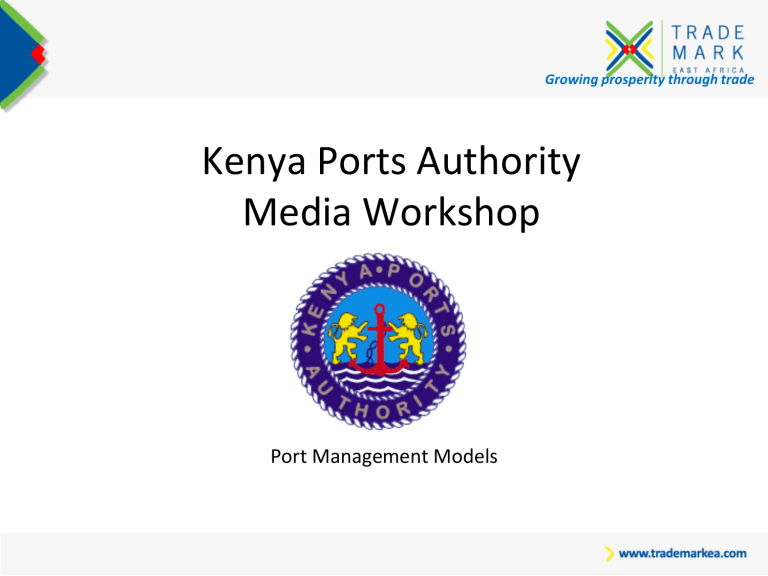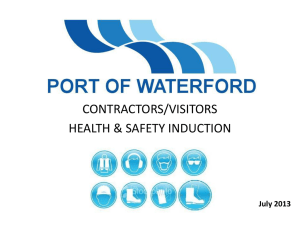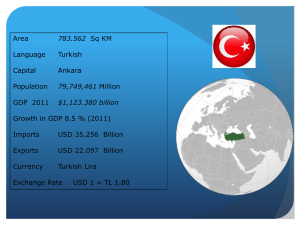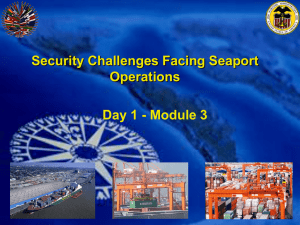KPA Media Workshop - Kenya Ports Authority

Growing prosperity through trade
Kenya Ports Authority
Media Workshop
Port Management Models
Public, Private, Mixed or Other Model
First and foremost: Understanding the nature of the port
• Green or Brown Field ?
• Small local port (County traffic only),
• Regional (more than one County), or
• International gateway (global orientation)
• Location and historical development
– why there and not somewhere else ?
• Types of cargoes handled
– liquid and dry bulk, general cargo, RoRo, containers, others
Public, Private, Mixed or Other Model
Secondly: Why Change?
• bottlenecks to efficient distribution ?
– Restrictive labour practice (associated with outdated methods of cargo handling matching available labour to occasional work)
– Centralized Government control (with slow-paced, rigid and hierarchical planning)
– Limited fiscal space
– Lack of finance
• Is it simple rent seeking ?
• Or White Elephants
“misinvestment” - facilities that were badly matched to traffic demand
Type of Model
Four main categories of ports have emerged over time:
1.
The public service port (Nationally or Municipal /County Owned)
• Service ports have a predominantly public character and the port authority offers a complete range of services required for its functioning. The port owns, maintains, and operates all asset (fixed and mobile), and cargo handling activities are executed by labour employed directly by the port authority .
2.
The tool port
• Whereby the port authority owns, develops and maintains the port infrastructure and superstructure including cargo handling equipment . Cargo handling is usually carried out by private cargo handling firms contracted by port authority.
3.
The landlord port
• Which is characterized by its mixed public-private orientation. Under this model, the port authority acts as regulatory body and as landlord, while port operations (especially cargo handling) are carried out by private companies (using their own equipment) . Typically infrastructure is leased to the private company and today, the landlord port is the dominant model in larger and medium sized ports.
Types of Model
4.
The fully privatized port
– In fully privatized ports (or private service ports) all land, infrastructure and superstructure is owned by private entities – often who are self-regulating. The state generally has little involvement of public policy interest.
Everything In-between
Strengths and Weaknesses
Options Depend on Business Model
Tariff
Critical to understanding how the port tariff works
Function Tariff Item Pays for Remarks
Marine Services
Marine Infrastructure
Cargo Infrastructure
Cargo Handling Services
Pilotage Services
Tug Services
Mooring and Unmooring Services
Other Services -MARPOL Provisions, Water
Navigation Dues
Port Entrance Dues
Dockage and Buoyage
Cargo dues or Wharfage (Ad Valorem)
Storage
Stevedoring
Shore Handling
Stuffing/Stripping
Bagging
Other
Vessels, Operating Costs
As above
As above
Services rendered to ships
Aids to Navigation/VTS
Capital and Maintenance Dredging
Quay and Port Facilities
Sometimes set below full infrastructure recovery cost to attract shipping lines
Subsidised by other port charges, especially wharfage)
Port Land, Roads, Rail, Utilities etc.
Additional space requirements due high dwell time
Sometimes on an ad
valorem basis - i.e. based on the customs declared CIF value of the cargo
Equipment and Labour costs for loading and offloading Ships
Equipment and labour for handling cargo in yards/sheds
Packing/Unpacking
Packaging (Dry Bulks)
Required Steps
• Options Analysis and Strategic Preparation
– Confirm affordability, value for money, form of PPP and risk sharing
– Identify constraints (for Brown Fields, establish labour task force)
– Establish the capacity if the private sector to deliver the project
– Identify indirect costs
– Undertake comparative assessments
Some Do’s and Don’ts
Dos
When facing a port’s capacity shortage, envisage more optimal use of the existing capacity
Don’ts
When facing port’s capacity shortage, immediately consider constructing new facilities
Conduct a careful assessment of the way the sector operates before investing in port infrastructure: understand demand before changing supply.
Necessarily privatize/concession a container terminal to reduce dwell time.
Inform public decision makers at highest levels (prime minister, ministries of economy and finance) on the need to implement public governance –related actions to build a broad coalition to change the equilibrium. This should include thorough analysis of the economic cost of poor system performance to the national economy.
Support measures that create new rents and reduce system transparency, such as proliferation of off-dock container yards.
Consider as a given that everybody is aware that transport and port “costs” are high, and address the issue of port delays only from a monetary cost perspective.
Sensitize the local population and trading communities on the importance of port clearance performance and the proper calculation of total logistics costs.
Report averages only with no distinct evaluation of good, average, and poor performance
Identify port performance indicators with a benchmark pegged to the most efficient shippers in the port.
Can be a win-win
Private Participation allows one to think-out-of-the-box






